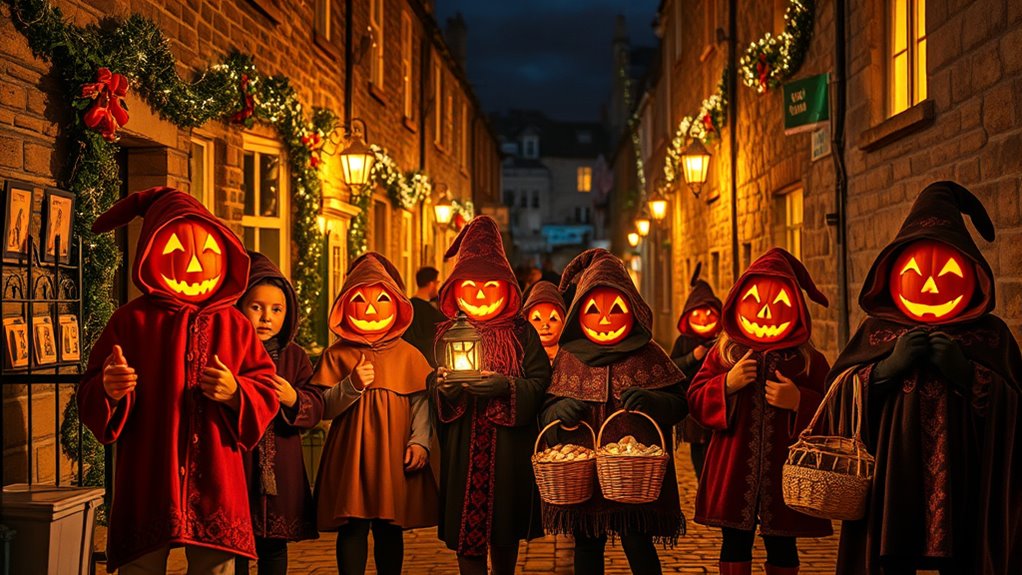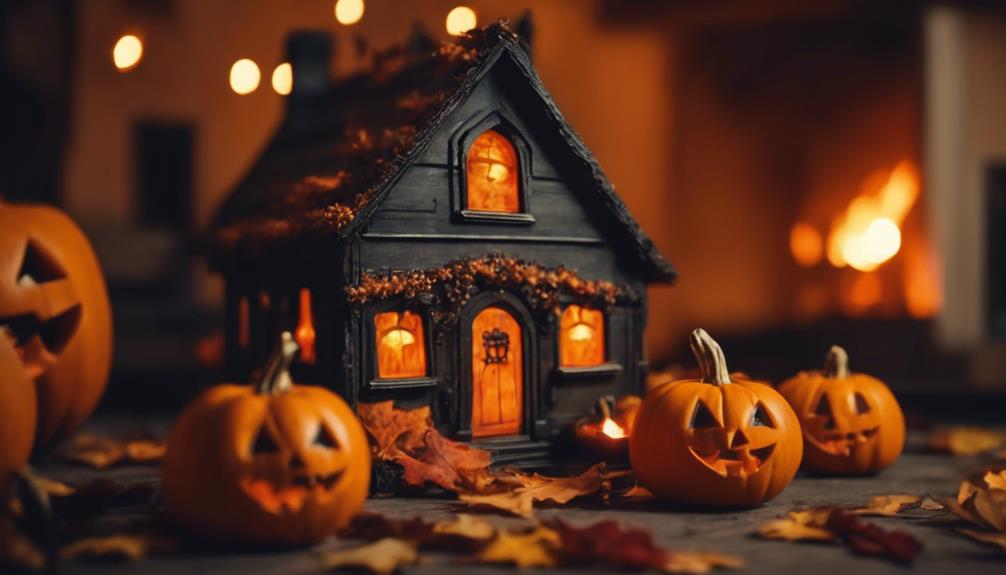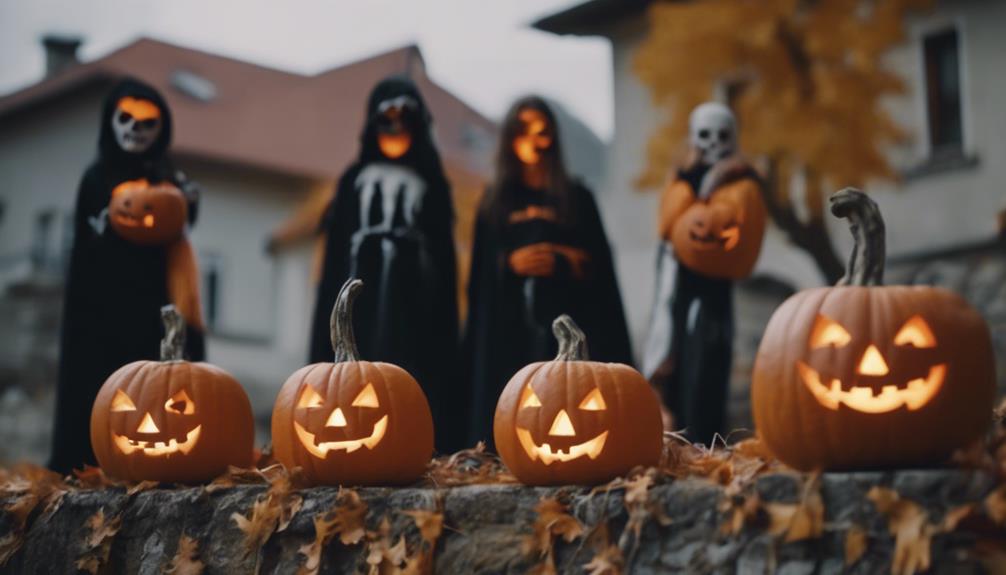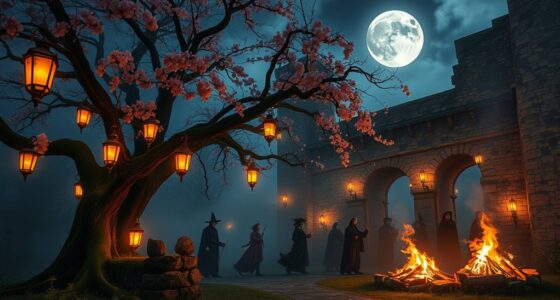In Scotland, guising is a centuries-old tradition where children dress in costumes inspired by folklore, history, or modern pop culture and go door-to-door, often singing or performing for treats. This festive activity has roots in customs meant to ward off evil spirits and celebrate Scottish heritage. Each region adds its own twist, from singing to storytelling. If you want to explore the rich history and unique regional practices further, there’s more to discover about this lively tradition.
Key Takeaways
- Guising is a Scottish tradition dating back centuries, involving disguises to ward off evil spirits during seasonal festivals.
- Costumes often feature masks, face paint, and folklore-inspired clothing, including mythical creatures and historical figures.
- The practice blends Scottish folklore, community celebration, and cultural heritage, with regional variations in customs and activities.
- Modern guising includes singing, performances, and creative costumes, maintaining community bonds and passing down traditions.
- The tradition celebrates Scottish history and folklore, evolving over time while preserving its significance in local communities.
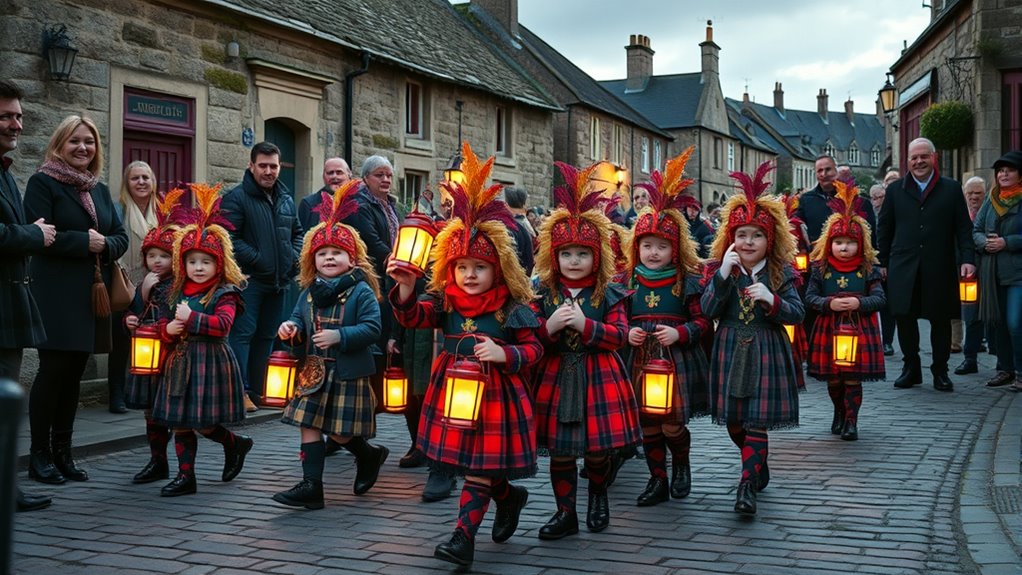
Guising is a vibrant Scottish tradition that dates back centuries, where children dress in disguises and go door-to-door during the Halloween season. This practice has deep roots in Scottish culture, evolving from older customs of disguising oneself to ward off evil spirits or to honor the changing seasons. When you participate in guising, you become part of a rich history that blends folklore, community, and celebration. The origins of the costumes, known as costume origins, trace back to ancient practices where people wore masks and disguises to hide their identities or embody spirits during seasonal festivals. Over time, these disguises shifted from spiritual protection to a more playful, festive purpose, especially as it became associated with Halloween. Today, the costumes often feature a mix of spooky, humorous, or traditional Scottish elements, such as masks, face paint, or clothing inspired by historical figures and folklore.
As you explore the tradition further, you’ll notice that regional variations shape how guising is celebrated across Scotland. In some areas, children might dress up as traditional Scottish characters like Highland warriors, fairies, or mythical creatures, reflecting local stories and legends. In others, the costumes incorporate more modern elements, blending contemporary pop culture with old customs. The regional variations also influence how children go about their guising activities. For example, in some communities, children sing songs or perform short skits before receiving treats, echoing older customs of performing for their neighbors. In others, the emphasis might be on simply knocking on doors and saying “trick or treat,” but with a distinctly Scottish twist, such as greeting neighbors with traditional phrases or wearing locally inspired costumes.
You’ll find that these regional variations make the tradition uniquely Scottish, highlighting local history and cultural identity. Despite the differences, the core idea remains the same: children don disguises to enjoy the thrill of the night and to partake in a communal activity that ties generations together. Whether your costume is rooted in ancient myth or modern trends, each disguise adds to the colorful tapestry of guising. This custom continues to thrive in Scotland, adapting over time but always maintaining its core spirit—celebrating community, creativity, and Scottish heritage. The practice of guising has also been preserved through community events that strengthen local bonds and keep the tradition alive for future generations. As you take part, you become part of a living tradition that links the present with centuries of Scottish history, making guising a truly special part of Scottish Halloween celebrations.
Frequently Asked Questions
When Did the Guising Tradition Originate in Scotland?
You might wonder when guising began, and its historical origins trace back to ancient Celtic festivals like Samhain, where disguises were used to ward off spirits. The tradition gained cultural significance over centuries, blending pagan customs with Christian influences. In Scotland, you participate in this lively practice around Halloween, dressing up and singing for treats. This evolving tradition reflects community spirit and a connection to ancestral roots, making it a cherished part of Scottish heritage.
How Has the Guising Tradition Evolved Over Centuries?
You see, the tradition has evolved through evolving disguises and modern adaptations over centuries. Originally, people wore simple masks and costumes to ward off spirits, but now, you’ll notice more creative and elaborate outfits. Celebrants often incorporate contemporary themes and humor, making the tradition lively and relevant. These changes help keep the spirit alive, blending history with modern culture, and ensuring everyone enjoys the festivities with fresh, exciting twists.
Are Guising Costumes Similar to Modern Halloween Costumes?
Picture playful, peculiar costumes, crafted with curiosity and creativity—are guising costumes similar to modern Halloween costumes? While tradition similarities exist, like disguises and door-to-door dares, contemporary costume design tends to be more colorful and commercial. You’ll notice that modern costumes often emphasize elaborate themes, while traditional guising outfits focus on disguises and storytelling. Despite differences, both celebrate community, costumes, and costumes’ cultural significance, creating enthralling, communal costumes that connect past practices to present festivities.
What Are the Regional Differences in Guising Practices Across Scotland?
You’re curious about regional differences in guising practices across Scotland. In some areas, costumes feature more traditional or elaborate regional costume variations, reflecting local culture. Elsewhere, local storytelling styles influence the performances, with certain regions emphasizing humorous or dramatic storytelling during guising. These variations showcase Scotland’s rich cultural diversity, making each area’s tradition unique. Overall, while the core idea remains, regional costume variations and storytelling styles add distinct local flavor to the practice.
How Is Guising Celebrated in Contemporary Scottish Communities?
You’ll find that guising today is a lively community event, with many families and local groups participating. Modern adaptations include themed costumes, street parades, and community performances, making it more inclusive and festive. You might see children and adults alike involved in traditional singing or storytelling, creating a vibrant atmosphere. Community involvement is key, as people come together to celebrate, preserving the spirit of guising while adding contemporary twists.
Conclusion
As you embrace the guising tradition in Scotland, remember it’s more than just costumes and treats. It’s a gentle reminder to keep the old ways alive, quietly passing stories from one generation to the next. Though the world changes, these customs softly hint at the importance of community and tradition, offering a subtle comfort that some things—like memories and shared moments—never truly fade away. In celebrating them, you find a quiet connection to the past.
